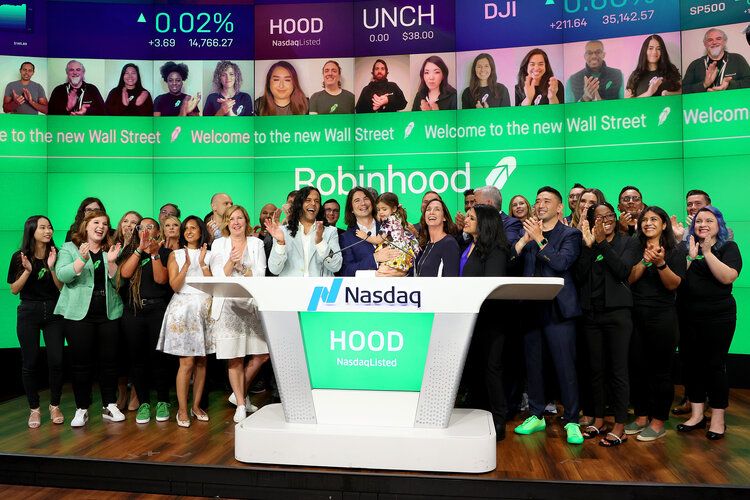Shares Fell On The First Day Of Trading. Time To Buy?
Founded in 2013, the pioneer of free trading forced the brokerage industry to drop commissions on retail trading, lowering the barrier for millions of new investors to access the stock market. During the pandemic, the app experienced record volumes of new retail traders entering the stock market. The rise has continued until 2021, marked by frenzied trading around so-called Meme stocks.
The company finally went public on Thursday and began trading at $38 per share, the low end of its range which valued the company at about $32 billion. After dropping as much as 10%, Robinhood's market capitalization closed down at $29 billion.
Growth supported by the rise of retail trading
Robinhood had 18 million clients as of March 2021, an increase from 7.2 million in 2020 (growing 151% year-on-year). The company now estimates that it counts over 22.5 million funded accounts. Which now hold around $ 100B in value for the second quarter of 2021.
Robinhood is the third largest brokerage based on the number of funded accounts behind Fidelity and Charles Schwab. Other competitors include Interactive Brokers and newer services such as Webull and SoFi. For comparison, Charles Schwab has a market capitalization of nearly $130 billion while Interactive Brokers has a capitalization of approximately $26 billion.
Payments for order flow
Robinhood is facing some key risks despite its rapid growth in the last few years. Most notably, the Securities and Exchange Commission is reviewing the payments for order flow or the money that brokerage firms receive for directing client trades to market makers. In the first quarter, this controversial practice accounted for about 80% of Robinhood's revenue. According to an SEC filing, the stock trading company accumulated a payment of $331 million for order flow in the first quarter of 2021.
"We think payment-for-order flow is a better deal for our customers, vs. the old commission structure. It allows investors to invest smaller amounts without having to worry about the cost of commissions," Robinhood CFO Jason Warnick by Maggie Fitzgerald for CNBC
Fading engagement
Robinhood, which benefits from volatility and a more speculative environment for its clients warned of a slowdown in trading revenues and account growth as the retail trading boom fades.
- Options trading accounts for about 38% of revenue, while equity and crypto accounts for 25% and 17% of revenues
- Robinhood also anticipates that the growth rate of new clients will be lower in the third quarter of 2021 than in the second quarter.
"We expect our revenue for the three months ending September 30, 2021, to be lower, as compared to the three months ended June 30, 2021, as a result of decreased levels of trading activity relative to the record highs in trading activity, particularly in cryptocurrencies" Robinhood Filing
BENCHMARK'S TAKE
- Robinhood derives the majority of its revenue from retail investors' more speculative investment such as options and cryptocurrencies
- With fading engagement from retail investors, Robinhood might very well be forced to find new ways to stimulate customer appetite and risk taking
- These may include further in-app gamification (or "gamblification") and may attract scrutiny from regulators
“become a very significant part of the casino aspect, the casino group, that has joined into the stock market in the last year or year and a half,” Warren Buffett by Maggie Fitzgerald for CNBC
Disclaimer
Please note that this article does not constitute investment advice in any form. This article is not a research report and is not intended to serve as the basis for any investment decision. All investments involve risk and the past performance of a security or financial product does not guarantee future returns. Investors have to conduct their own research before conducting any transaction. There is always the risk of losing parts or all of your money when you invest in securities or other financial products.
Credits
Photo by Robinhood.






